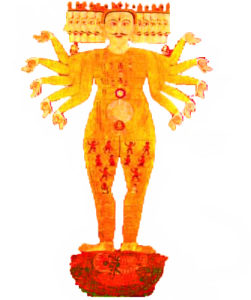
The Universe as a Cosmic Man, with Vishnu at the base, Krishna and Radha at the top. Nepal, 17th century. Gouashe on cloth, 61 x41.
 here is perhaps no phenomenon as complex as `culture’. In a manner of speaking, culture is everything in a particular society, and one can as easily speak of the culture of Hindustani music and Bengali bhadralok society as one can of the culture of the working-class, Hindi film-viewers, rickshaw-pullers, and India’s modernizing elites. Indian culture is no easy composite of varying styles and influences. In the matter of cuisine, for instance, the North and the South share little, and these broad categorizations say little about the distinctions between the peppery hot food of Andhra and the coastal, largely coconut-based, cuisine of Kerala. Likewise, in thinking of architecture, one’s mind traverses from the great temple cities of the South — Chidambaram, Rameswaram, Kanchipuram, Madurai, and numerous others — to the architectural splendors of the Vijaynagar empire and the erotic sculptures of Khajuraho to the grand Mughal architecture of Delhi, Agra, and Fatehpur Sikri. And what of modest roadside shrines, the step-wells of Gujarat, or the havelis of Jaisalmer with their impeccable lattice work? But culture is not only a matter of music, dance, art, and cinema, for marriage customs, death rites, patterns of pilgrimage to holy cities, modes of raising children, treatment of elders, and innumerable other aspects of everyday life are stitched into the meaning of culture.
here is perhaps no phenomenon as complex as `culture’. In a manner of speaking, culture is everything in a particular society, and one can as easily speak of the culture of Hindustani music and Bengali bhadralok society as one can of the culture of the working-class, Hindi film-viewers, rickshaw-pullers, and India’s modernizing elites. Indian culture is no easy composite of varying styles and influences. In the matter of cuisine, for instance, the North and the South share little, and these broad categorizations say little about the distinctions between the peppery hot food of Andhra and the coastal, largely coconut-based, cuisine of Kerala. Likewise, in thinking of architecture, one’s mind traverses from the great temple cities of the South — Chidambaram, Rameswaram, Kanchipuram, Madurai, and numerous others — to the architectural splendors of the Vijaynagar empire and the erotic sculptures of Khajuraho to the grand Mughal architecture of Delhi, Agra, and Fatehpur Sikri. And what of modest roadside shrines, the step-wells of Gujarat, or the havelis of Jaisalmer with their impeccable lattice work? But culture is not only a matter of music, dance, art, and cinema, for marriage customs, death rites, patterns of pilgrimage to holy cities, modes of raising children, treatment of elders, and innumerable other aspects of everyday life are stitched into the meaning of culture.


